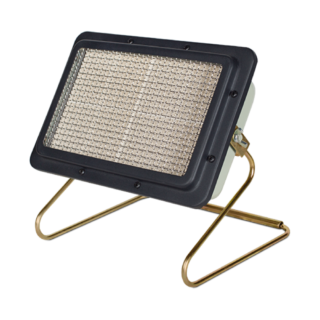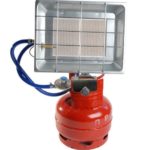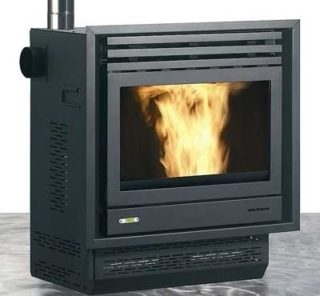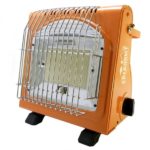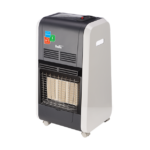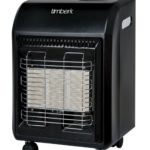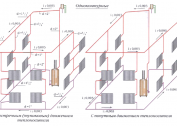Owners of country houses and those who wish to spend time in the country during cold periods need to think about heating. Electrical appliances consume quite a lot of resource, which is expensive. The best option would be to install a gas heater. For the device to work as it should, it is important to choose the right model and familiarize yourself with the operating rules.
Classification of gas heaters
There are a lot of options for gas heaters, their differences are in the principle of action and mobility, in constructive and power indicators. But for the operation of any of the devices, liquefied or natural fuel is required, which they convert into thermal energy. As a source, you can use balloon gas or connect to a common highway.
There are two types of heating devices: stationary and portable. The first are installed for a long time and are used as the main heat sources. Such devices are distinguished by large dimensions and great efficiency; for their operation, it is necessary to mount a chimney that displays combustion products.
Mobile models are used for temporary or semi-permanent heating. They have smaller sizes and performance. They cope well with heating cottages, small houses, garages and outbuildings where there is no centralized gas supply.
Infrared and catalytic devices, convectors and heat guns
According to the principle of operation, heating devices are divided into the following types:
- Infrared Burners with metal or ceramic radiators are installed inside. When heated, they begin to emit infrared waves. To direct them in the right direction, use the built-in reflectors. At the same time, the air near the heaters remains almost cold - only surrounding objects are heated. The infrared gas ceramic heater is the safest. The use of ceramic plates allows to achieve absolute combustion of fuel without any harmful emissions.
- Convection. Their main element is conventional burners, which are responsible for burning fuel. The air is heated using special finned radiators. Thanks to convection, heated flows rise upward, and cold air masses take their place. Two to three hours after start-up, the heated room becomes noticeably warmer.
- Catalytic. The design uses the principle of oxidation of natural or liquefied gas. There is no flame; heat is generated through a chemical reaction. Gas enters a special catalytic panel, where it is oxidized, so that heat is generated. For heating, catalytic devices with an infrared output or convector, combined, are also used.
- Thermal gas guns. They are made in the form of a cylinder and operate as a fan heater. A heat generator is used as a heating element. They work from bottled gas, power adjustment is carried out by a reducer.
- Catalytic heater
- Heat gas gun
Infrared and convection gas heaters are ceiling, wall and floor.
If catalytic devices are used for the most part for heating the internal parts of the building, then infrared devices with burners provide the possibility of heating outdoor areas for recreation, summer cottages, restaurant terraces.Such devices are able to distribute heat at a decent distance - for example, street models can heat objects within a radius of 5-6 meters.
Most often, a gas infrared heater works from a cylinder, since such devices are classified as mobile equipment. Also among such equipment there are models equipped with slots for connecting built-in cylinders up to 27 liters. If you intend to use the device indoors, you can connect the IR device to the trunk pipe using a flexible hose.
Gas stoves and fireplaces
In a separate group include stationary gas furnaces for summer cottages. These devices are similar to those that work on wood, but they connect gas to the burner in the furnace compartment. There are also small mobile stoves with remote pipes. Modern models have automatic adjustment systems, which saves “blue fuel” and maintains a constant temperature in the room.
Gas stove air heaters are made of cast iron or high-strength steel and must be equipped with a chimney. Stationary options are sometimes bricked for better heat retention.
Combi ovens that can operate on solid fuels and liquefied gas are also on sale. To increase efficiency, chimneys are equipped with special fans. Also, to save heat, it is better to choose a gas stove for a summer residence with a closed combustion chamber.
A variety of stoves are gas fireplaces. They can be connected to the highway or run using a cylinder. Now remote models for summer cottages, which allow heating and adding aesthetics to the veranda or outdoor recreation area, have become popular.
Advantages and disadvantages of equipment
Gas cylinder heater has several advantages:
- mobility;
- reliability;
- compact dimensions.
The natural gas heater is larger, but more powerful. These types of devices are also quite economical, especially in comparison with electric heaters. Fuel consumption for heating the room is not too large.
The disadvantages of gas-fired heating devices include the fact that they burn air, and are also capable of emitting toxic products into the atmosphere, which is especially dangerous if the combustion chamber is open. Then they will go straight to the living room. Without the installation of automatic shut-off and fuel-cut systems, equipment cannot be considered safe.
Natural gas heaters are suitable for continuous operation if there are problems with the heating system. However, if you need to transfer the unit to another room, you will have to re-plan the gas pipeline, which is quite expensive.
Criteria for choosing a heater for a summer residence
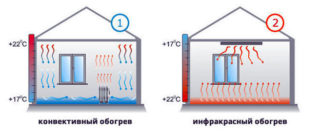 When choosing a gas heater, it is necessary to consider the purpose of the equipment. If heating is required for a long time, a stationary gas convector should be preferred. If the device is needed for a temporary stay in the country, where gatherings on the veranda are supposed, the ceramic infrared device will be an ideal option.
When choosing a gas heater, it is necessary to consider the purpose of the equipment. If heating is required for a long time, a stationary gas convector should be preferred. If the device is needed for a temporary stay in the country, where gatherings on the veranda are supposed, the ceramic infrared device will be an ideal option.
There are other criteria for choosing a good device that you should consider. First of all, it is the power on which performance depends. The indicator should be consistent with the intended use. A device with a power of 1 kW will warm up well to fifteen "squares". If 4 kW is indicated in the data sheet of the device, the unit is suitable for rooms up to 60 m2. It is not necessary to purchase devices of high power for seasonal operation, since the device will not be able to work at full strength, and you will have to spend much more money.
It is also necessary to verify the capabilities of the unit and its costs. Devices, depending on power and functionality, can cost from two to 30 or more thousand rubles. Price depends on feature set and brand.The most high-quality equipment suitable for domestic gas lines and cylinders is produced by the following companies:
- Ballu (an international company headquartered in Hong Kong);
- Bartolini (Italy);
- Timberk (Sweden);
- The Pathfinder (Russia).
- Ranger
- Ballu
- Bartolin
- Timberk
The first company has branches in Russia. The popular and affordable Ballu Bigh-55 is available here.
Pay attention to the heating temperature inside and outside the device. The higher the first indicator, the faster the room warms up. The case of the unit should not get too hot, otherwise it will be dangerous to operate the device in everyday life.
Dimensions, weight, ease of transportation influence the choice. A plus will be the availability of special devices to improve mobility, such as a handle or wheelbase, as well as piezoelectric ignition, and moisture protection functions. Its level, as a rule, is indicated in the marking on the surface of the housing.
If you need a portable option, take a look at models with an internal gas bottle retainer. Functions to reduce the risk of ignition are also important - in particular, auto shut-off and overturn protection. Buy the unit only in a special store, so that the product has a technical passport, a guarantee for service.
Security questions
Before purchasing a device, you should carefully read the documentation, quality certificates and instructions for using the device. Inspect the unit itself - the case must be intact, without cracks and dents.
After delivery, read the manual again. If you plan to connect to a gas pipe, call a specialist. The cylinder can be connected independently.
If the device is supplemented by an electrical device, such as a fan, periodically check the plug and cord, as well as sockets, wiring, and shields. Slight damage can lead to shorting of electrical wires and fire, and, given the gas, even explosion.
It is necessary to take into account certain prohibitions when using gas equipment. Not allowed:
- Installation of home-made heating units with open heating elements.
- Use of appliances that have expired. It averages ten years.
- Installation of devices in the bathroom, hallway, close to furniture, electrical appliances, curtains and curtains, cabinets with flammable liquids and paints.
- Fixing wall convectors without special supports.
- Drying washed laundry over the heater.
- Admission of children to the room where gas equipment is installed.
It is allowed to connect no more than two heaters to one chimney. Moreover, the distance between them along the stroke should not be less than half a meter. The material of which the chimneys are made should be distinguished by corrosion and acid resistance. If there is no coaxial pipe, a good ventilation system is needed in the house to instantly eliminate combustion products.
Gas equipment, if weather conditions permit, it is better to turn off at night. Be sure to turn off the appliances when leaving home, leaving.
Gas heaters quickly and effectively help create thermal comfort in an unheated house or cottage. With the right selection, they will last a long time and will be absolutely safe to use.
